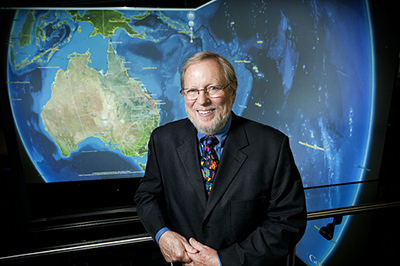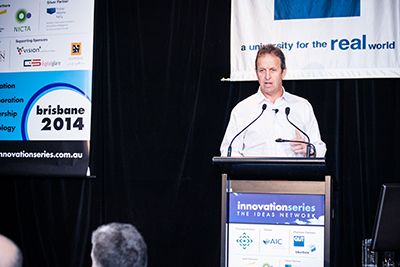By Mike Sullivan >>
THE catchphrase ‘big data’ makes some of the people who use it most … well, uncomfortable. Perhaps that is because it makes the use of universal data sound like a ‘techno fad’ when it is actually a profound and lasting change to the way business will be done.
Simply put by QUT’s SIBA chair in spatial information, Tim Foresman, who has formerly worked in the big data sphere for NASA and as United Nations chief scientist, “How does your business strategy change when you are not just looking at statistics – or just a very small part of the data – but you are looking at all of the data? A lot.” 
Scientist Dr Foresman joined an expert in the business application of big data in Australia, Tony Davis of Quantium, on stage at the recent Innovation Series event in Brisbane to enliven minds to the possibilities of big data for better business strategy and decision making.
Both agreed, and evidenced, that the application of big data to incite innovation, creativity and decision making was a seismic shift that business leaders were steadily getting their heads around.
But both agreed that Australia – and Queensland in particular, with the opening up of its spatial information on the Queensland Globe – was taking a lead in the sphere, largely because of the Queensland Government’s decision last year to open up its data sets for public and business use.
“Those actions stimulate the business community like never before,” Dr Foresman said. “One million downloads in June from Queensland Globe. Steve Jacoby (executive director for land and spatial information at the Natural Resources and Mines Department) – true leadership for what he accomplished.”
But both Dr Foresman and Mr Davis urged business to re-think how it is – and is not – using data to drive better decision making. In Mr Davis’s case, he said Quantium customers, such as Woolworths – now a part owner of Quantium – were using big data analysis to get closer to understanding customers and potential customers and trying to build better relationships.
“In medicine in government in science – all these things are data rich,” Mr Davis said. “You could argue that business is relatively late to the data question.
“I would argue that and it is certainly a journey. The clients we work with at Quantium are at different places on that journey.
“I think the phrase big data is misunderstood,” he said.
“Data is becoming very central to everything in business. Using data to understand customers better than you’ve ever understood customers before is the source of true innovation and true competitive advantage.
“Jack Welch (former CEO) of GE said there are only two sources of competitive advantage: the ability to learn more about our customers faster than our competitors and the ability to turn that learning into action faster than our competitors.
I think that is entirely true of the businesses that are prevailing in the current competitive landscape and those that will succeed in the future are those that can harness data. 
“The comment about data being to the digital revolution hat oil was to the industrial revolution, I think, is completely true. It is the reason that I dislike the phrase big data.
“Big data suggests it’s a trend, suggests it’s a fad. The reality is following the earthquake that was digitisation maybe 15 years ago, the tsunami of data that has appeared is a reality that is not going to go away. This is a new reality that we all need to deal with.”
It is no coincidence that Quantium’s lead in this area has grown out of the firm’s original formation 12 years ago as actuaries, working mainly for large insurance firms.
“We started as an actuarial consulting firm,” Mr Davis said. “We would argue that actuaries were the data scientists in business and the industry was only really invented from using all sorts of data sources, about 30-40 years ago.
“It is all about being able to understand customers with a view to being able to accurately predict what might happen to them, in order to preserve the very fine margins in the general insurance industry.”
Mr Davis said applying actuarial skill sets, both analytical skills and commercial acumen, has delivered major success for Quantium in a relatively short period of time.
“We work with a wide range of clients that are data rich and data driven by mentality,” he said. “We really think here is an interdependence between certainly three of these capabilities – data, analytics and technology – and the application of insights that come from data, analytics and technology.”
DIGITAL WORLD VIEW
In Dr Foresman’s explanation of the origins of big data – dating from the Mesopotamian census – he arrived at the explosion of ‘big data’ brought about initially by satellite photography.
This drove mapping, spatial and observational data that has since been applied in ways never envisioned at a time when film canisters were ejected from orbit to be ingeniously captured by tracking aircraft flying below.
“Today we look at it and say you’ve gotta be kidding – but that’s the way they did it,” Dr Foresman laughed. “And that was big data, to say the least. Large amounts of data.
“This led to a new way of monitoring the planet … then everybody started to get it back in 1968 when we started to see our little blue orb (from space) and said it would be kinda neat to use this data to protect this little planet we are on.
“So society, business, everybody started to think about it a little differently.”
Digital technologies has not only provided the emergence of major data collection, it had provided the means to make use of it, Dr Foresman said.
“How do you explain the changes on the planet without satellite monitoring?” he asked. “Very difficult.
“The beauty is, now we can start looking at it from a computer. In 2001 four young programmers were hired by me at the UN to put together a little demonstration and (he showed an image of spatial mapping data on screen) you’re seeing the very first thing ever done by a company called Keyhole.
“It was bought out a few years ago by a little start-up company called Google (and became the basis for Google Earth). That was how these things started.”
Dr Foresman said the power of presenting digital data sets through imagery cannot be underestimated – and this was an area where business leaders needed to catch up.
“We show maps we see things changing rapidly … it’s still hard to get our brains around this,” he said. “ I don’t think we do. Our brains don’t work that way. We see this thing called big data and we only see a little bit of it.
“Regardless of what we see, we realise we need to shift our business strategy and really jump ahead.”
Mr Davis said in Quantium’s experience, technological processes were very often applied in the media space, “which is really where the rubber hits the road in terms of significant expenditure in business and certainly in the marketing space”.
“We think the insights you might derive from the data and analytical space are really only of innovative value if they are applied,” Mr Davis said.
CUSTOMER INSIGHTS WITH DATA
Mr Davis is adamant that all the big data research in the world is a wasted exercise unless it is applied – and in the business space the most vital insights centre on customers.
“Insight to activation is a phrase that we think is extremely important in order not just to be stuck in the world of analytical theory,” Mr Davis said. “Which is very interesting and gives you a warm feeling, but does not actually give you any improvements in your competitive performance or impact on your profit and loss.”
“If understanding the customer is the source of new insight and new strategy leading to competitive advantage, it isn’t any easier to understand consumers now. Consumers are employing all sorts of behaviours that we never used to do, particularly around digitisation.
Mr Davis admitted that he was “famous” for giving market researchers “a little bit of a bloody nose”.
“My view is that market research is outdated,” he said. “If you are asking customers what they did or what they think they might do next, you ae already too late.
“If you are not using proper data on what they have actually done – not what they say they will do, or what they say they have done – then you are already too late in the cadence in which business operates.
“Your best customers are very unlikely to be the people who are time rich enough to fill in a survey. They certainly may not be on Facebook and ‘like’ you. They certainly don’t go to focus groups. They may not tell you anything about themselves by their own efforts. But you do know an awful lot about them from the data that you want to gather on them.
“Henry Ford said, if I had asked the public what they wanted they would have asked for a faster horse.
“The point about the cadence of business and the cadence of technology and data and insight is upon us as businesses and organisations of any type, we have a duty to use that data in order to increase the engagement and relevance of engagement with our consumers in a way that they cannot possibly imagine,” he said.
“By analysing data and understanding customers powerfully, we are able to develop true insights into customers and audiences and deliver a valuable relationship with consumers that has just not been possible before.”
Mr Davis said businesses should look at the data they already collect on their customers and utilise it first. He gave the example of simply examining transactions on credit card statements.
“Data derived from credit card statements and any kind of electronic transactions source … the types of insights derived beyond the time of day and the amounts spent in retail and other situations in which you might use an electronic payment method,” he said.
“You are able to start to infer and deduce the family status, the frequency of shopping the amount of spend, the particular retail categories, whether the customer is time rich or time poor, whether they shop online late in the day, they engage with pay television not free-to-air and they may even consume their free-to-air through a pay TV box.
“From their fuel purchases you can see the frequency and value of the transaction, fuel and so on, RTA, all sorts of things. You can start to paint a really valuable picture. Of the types of customers, their age, their sex and their geography and you can start to paint powerful pictures of which consumers are behaving in which ways.
“This is not guesswork. This is understanding which types of customers are spending how much money and in which types of retail situations,” Mr Davis said.
“Beyond that you can look at customers’ basket data.” This is possible through loyalty programs, for example. “You can identify whether they are a mainstream brand purchaser or whether they buy own-label in different categories. Do they buy stuff that is on promotion or has been promoted in the catalogue? So you can kind of see which people are promiscuous and switch between brands.
“The point is, this is not clever data analysis. This is a clever understanding of customers that is under most businesses’ noses that they are still not yet using. This is about the journey around big data.”
PREDICTIVE DATA
The ‘holy grail’ of big data – using it to accurately predict future outcomes or behaviours – is already upon us, Mr Davis and Dr Foresman agree. But the real take-up is yet to come.
“One of the other things that data and smart insights can derive that consumer marketing in the business space is not just understanding your own customers,” Mr Davis said. “Most organisations know about the customers with whom they already have a relationship. Of course you do.
“What you rarely do is have an understanding of the types of customers that are shopping in your category but with your competitors. How do those customers vary?
“Partial data is also a danger. But understanding not only your customers but where your competitors are and where are the big consumers in your category going – and what do they look like compared to our customers?
“It gives you enormous insights into your future proposition, pricing, promotional strategies.”
Mr Davis described a Walmart program in the US that took this to an early extreme.
“Walmart developed their data capabilities to such an extent that they are able to identify customers of Walmart when they are parking their car in Safeways … their arch rival in certain locations,” Mr Davis said. “They are able to ping those people with an SMS to say we think you are about to buy a certain product, come over to Walmart and we will either price match or price beat.
“They have taken this a step further. They can identify their customers who are on their equivalent of Everyday Rewards, so they know everything about them and those customers have also signed up to have their data used on a private personal basis.
“They have identified that they have in the past bought certain hair straightening products and, at a certain level of dewpoint or humidity, they will ping customers and say, ‘Have you got this? Otherwise that frizzy hair is coming back …”
Mr Davis said being able to target customers with similar amounts of precision and with that timeliness is not far away.
“However, one man’s relevance is another man’s creepiness, so we need to recognise that we need permission to do this – from a brand relationship point of view and also from a regulatory point of view. It’s not a small consideration.”
In a lyrical part of his Innovation Series presentation, Dr Foresman referred to a movie image of actor Charlton Heston, as Moses, carrying stone tablets down from the mountain.
“But carrying big data around in those times became a bit of a challenge, to say the least,” Dr Foresman quipped. “But some found it was very good, as he who holds the big data is now influencing a variety of folks. Influencing governments and influencing people, if you are controlling the data.
“It’s the oil of the economy. It’s a fishing expedition for innovation and creativity.
“The benefit is that you don’t have to pay for the big data to happen. It is being volunteered by vast hoardes of folks, using incredible amounts of these ‘field units’ that you did not have to pay for, being pumped out of China – 26 times the population of Australia of these things are being pumped out next year.
“I didn’t pay for the data collectors and I did not pay for the equipment. This is awesome.
“There is a message from the mountain and we shall deliver the message,” Dr Foresman grinned..
“How shall I behave? How shall I create economic value? How shall I analyse more data? Lots more data. Thou shalt gain insight. Thou shall leverage big data.”
www.quantium.com.au
www.qut.edu.au
www.innovationseries.com.au
ends

 How to resolve AdBlock issue?
How to resolve AdBlock issue? 






